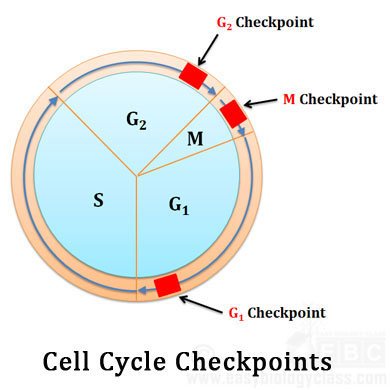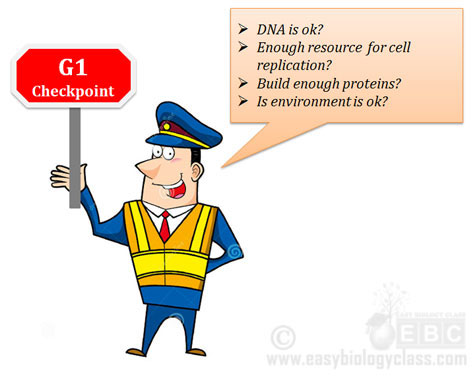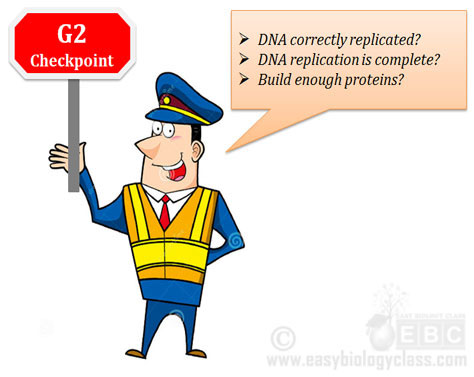What is cell cycle checkpoint?
Every cell in our body pass through a series of different stages in a cyclic manner called cell cycle. Cell cycle is a sequential step that taking place in a cell leading to the accurate duplication of genetic materials (DNA), precise separation of replicated genetic materials and passing them in to two daughter cells. The process of cell cycle is very critical in each cell, thus it operate strictly under strong surveillance to prevent any mistakes. This strong surveillance system in the cell to monitor the cell cycle progression itself is called cell cycle checkpoints.
Checkpoints are surveillance mechanisms that halt the progress of cell cycle if (1) any of the chromosomal DNA is damaged, or (2) critical cellular processes, such as DNA replication during S phase or chromosome alignment during M phase, have not been properly completed. Thus cell cycle checkpoints ensure that the various events in the cell cycle progression occur accurately and in correct order. In this post we will discuss the three types of cell cycle checkpoints that operate in eukaryotic cells during cell cycle progression.
| You may also like NOTES in... | ||
|---|---|---|
| BOTANY | BIOCHEMISTRY | MOL. BIOLOGY |
| ZOOLOGY | MICROBIOLOGY | BIOSTATISTICS |
| ECOLOGY | IMMUNOLOGY | BIOTECHNOLOGY |
| GENETICS | EMBRYOLOGY | PHYSIOLOGY |
| EVOLUTION | BIOPHYSICS | BIOINFORMATICS |

Progression of cell cycle in eukaryotes is highly regulated in certain points. These critical regulatory points of cell cycle are called cell cycle checkpoints.
Cell cycle checkpoints ensure that:
Ø The nuclear genome is intact (without any mutation)
Ø The conditions are appropriate for a cell to divide (enough nutrients is there for the daughter cells)
Ø Genetic material is replicated only once in a cell cycle
Ø Genetic material is completely replicated
Ø No mutations occurred in the replicated chromosomes
Ø If mutations are occurred, these mutations will be rectified by DNA repair system
Ø Chromosomes are correctly oriented in the metaphase plate
Ø All chromosomes are correctly attached to the spindle fibres
What are cyclins and cyclin dependent kinases (cdks)?
Two categories of related proteins called cyclins and cyclin-dependent kinases (cdks) orchestrate the cell cycle checkpoint in eukaryotic cells. The cyclins are so named because their amount varies throughout the cell cycle. To be active, the cyclin dependent kinases (cdks) controlling the cell cycle must bind to a specific cyclin. Number and types of cyclins and cdks varies from species to species. The level of different cyclins and cdks are also different in different phases of cell cycle.
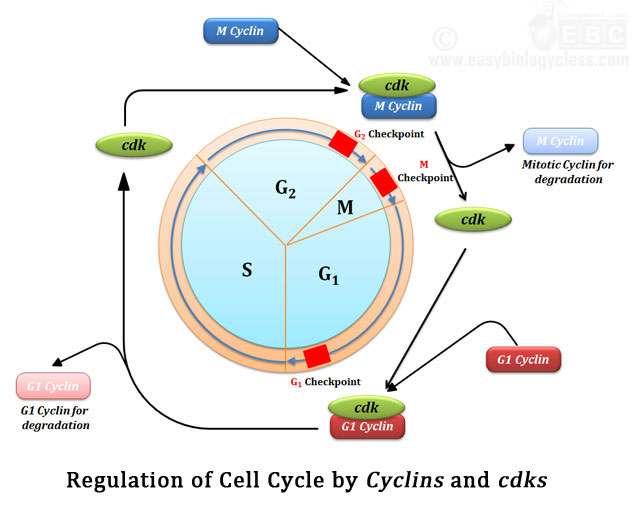
- .
Different types of checkpoints in cell cycle:
Checkpoint proteins, act as sensors to determine if a cell is in the proper condition to divide. There are three checkpoints in a cell cycle.
(1). G1 checkpoint (restriction checkpoint)
(2). G2 checkpoint (G2-M DNA Damage Checkpoint)
(3). Metaphase (M)-checkpoint (Spindle assembly checkpoint)
(1). G1 checkpoint:
G1 checkpoint is also called as restriction point. G1 checkpoint operates at the end of G1 phase of cell cycle. G1 check points checks whether the conditions are favorable for the cell to divide. It also checks the DNA for any damage before it is going for a cycle of DNA replication in the next phase (S phase). If DNA damage is detected, checkpoint proteins will prevent the formation of active cyclin/cdk complexes. Inhibition of cyclin/cdk complex formation stops the progression of the cell cycle. The cells are then direct the DNA repair mechanism to rectify the DNA damage. If the environmental conditions are not good, the cell may enter into G0 phase. In yeast cells, G1 checkpoint is also called as start point.
(2). G2 checkpoint
G2 is the second checkpoint which operates at the end of G2 phase. It is also called as G2-M DNA damage checkpoint. G2 checkpoint checks the DNA for any damage that might be occurred during the DNA replication in the previous cell cycle phase (S phase). G2 checkpoint also ensures that the entire DNA has been replicated completely. Apart from this, G2 checkpoint monitors the levels of proteins and growth factors that are needed in the next phase (M phase) of cell cycle. If any of the above factors are not satisfactory, the G2 check point hold the cells at G2 phase and initiate machineries to rectify the problems.
(3). Metaphase (M) checkpoint (spindle assembly checkpoint)
Metaphase checkpoint is also called as spindle assembly checkpoint. It is the third and last cell cycle checkpoint in a cell cycle operates at the end of M phase. Metaphase checkpoint senses the integrity of the spindle apparatus 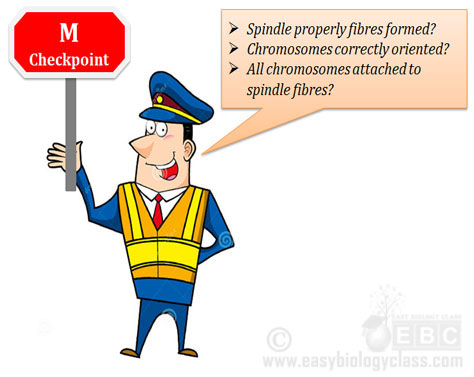 in the cell. Spindle apparatus is involved in sorting of chromosomes during cell division. Correct orientation of chromosomes in the metaphase plate of cell is very essential for the proper segregation of chromosomes. If chromosomes are not correctly attached to the spindle apparatus, the metaphase checkpoint will stop the cell cycle. Thus, M checkpoint prevents cells from incorrectly sorting their chromosomes during division.
in the cell. Spindle apparatus is involved in sorting of chromosomes during cell division. Correct orientation of chromosomes in the metaphase plate of cell is very essential for the proper segregation of chromosomes. If chromosomes are not correctly attached to the spindle apparatus, the metaphase checkpoint will stop the cell cycle. Thus, M checkpoint prevents cells from incorrectly sorting their chromosomes during division.
| You may also like... | ||
|---|---|---|
| NOTES | QUESTION BANK | COMPETITIVE EXAMS. |
| PPTs | UNIVERSITY EXAMS | DIFFERENCE BETWEEN.. |
| MCQs | PLUS ONE BIOLOGY | NEWS & JOBS |
| MOCK TESTS | PLUS TWO BIOLOGY | PRACTICAL |
What are the importance of cell cycle checkpoints?
@. Checkpoint proteins delay the cell cycle progression until problems are fixed
@. Checkpoint can prevent cell division when problems cannot be fixed
@. They can induce apoptosis (programmed cell death) if the problems are so severe and cannot be repaired
@. Cell cycle checkpoints accurately maintain the genome of the organism
@. Cell cycle checkpoint ensure only one round replication of DNA per cell cycle
@. If functions of checkpoint genes are lost due to mutation, leads to additional mutations and cancerous growth initiate in the organ
@. Almost all cancers are due to the improper functioning of either one or many proteins involved in cell cycle regulation. (Eg. P53 – guardian of genome, a tumor suppressor gene)
<<Back to Molecular Biology Notes

